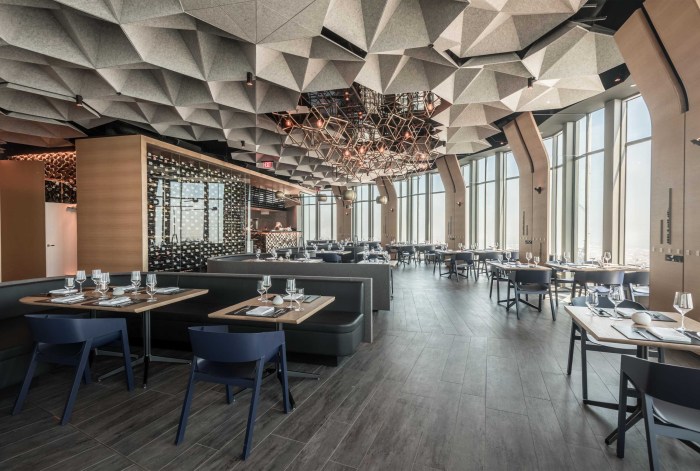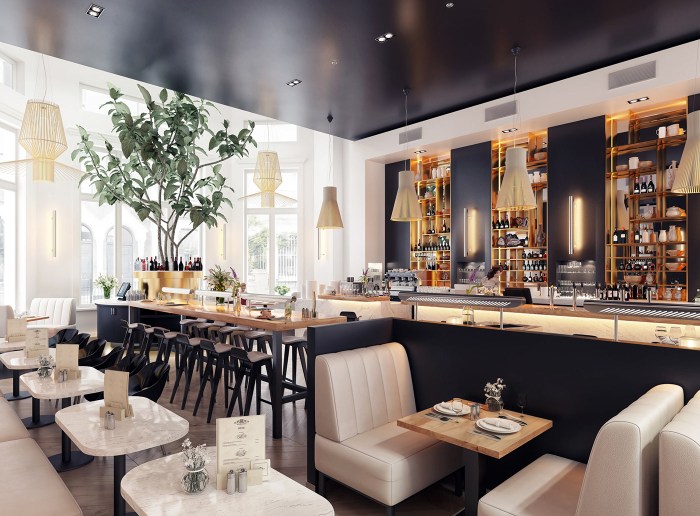Crafting a Modern Restaurant Design: Key Elements and Innovative Concepts

Embark on a journey into the realm of modern restaurant design, where creativity meets functionality to redefine dining experiences. From sleek materials to cutting-edge technology, discover the essence of contemporary dining spaces.
Elements of Modern Restaurant Design

Modern restaurant design encompasses various key elements that contribute to creating a sleek and contemporary ambiance for diners. The use of specific materials, lighting techniques, and furniture plays a crucial role in shaping the overall aesthetic of a modern restaurant.
Materials like Glass, Steel, and Concrete
In modern restaurant design, materials like glass, steel, and concrete are often utilized to achieve a clean and industrial look. Glass allows for transparency and light to flow through the space, creating an open and airy atmosphere. Steel adds a touch of sophistication and durability, while concrete brings a sense of urban chic to the design.
Role of Lighting
Lighting is a fundamental aspect of modern restaurant design as it sets the mood and ambiance of the space. Strategic use of lighting fixtures, such as pendant lights, track lighting, and recessed lights, can highlight architectural features, create focal points, and enhance the overall dining experience.
Dimmable lights are often used to adjust the brightness according to the time of day and desired atmosphere.
Minimalist Furniture and Clean Lines
Minimalist furniture with clean lines is central to modern design concepts in restaurants. Sleek and simple furniture pieces, such as wooden chairs, metal bar stools, and modular tables, contribute to a clutter-free and contemporary aesthetic. The emphasis on minimalism allows for a sense of spaciousness and sophistication in the dining area.
Layout and Space Planning

Efficient layout designs play a crucial role in maximizing space utilization in modern restaurants. By carefully planning the layout, restaurant owners can create a functional and visually appealing space that enhances the overall dining experience for customers.
Importance of Open Floor Plans and Flexible Seating Arrangements
Open floor plans have become increasingly popular in modern restaurant design due to their ability to create a sense of spaciousness and connectivity. By removing physical barriers and partitions, open layouts can make the restaurant feel more inviting and allow for better flow of movement.
Flexible seating arrangements also contribute to maximizing space usage. By incorporating a mix of different seating options such as booths, communal tables, and bar seating, restaurants can cater to various group sizes and dining preferences, ultimately increasing the overall seating capacity.
Zoning Different Areas for Enhanced Customer Experience
Zoning different areas within a restaurant, such as the dining area, bar, and waiting area, can significantly enhance the customer experience. By clearly defining these spaces, restaurants can create a sense of organization and purpose, leading to improved efficiency and customer satisfaction.
For example, a well-defined waiting area can help manage customer flow during peak hours, while a designated bar area can provide a lively atmosphere for guests looking to enjoy drinks and socialize.
Incorporating Technology for a Modern Touch
Integrating technology seamlessly into the design of a modern restaurant can elevate the overall dining experience. From digital menu boards and online reservation systems to interactive tabletops and mobile payment options, technology can streamline operations, improve customer service, and create a more engaging environment for diners.
Color Schemes and Finishes
When it comes to modern restaurant design, color schemes and finishes play a crucial role in creating a visually appealing and inviting space for customers. The right combination of colors, textures, and finishes can enhance the overall dining experience and leave a lasting impression on guests.
Popular Color Schemes and their Psychological Effects
- Neutral Palette: Shades of white, beige, and grey are commonly used in modern restaurant design to create a sense of elegance and sophistication. These colors can also evoke feelings of calmness and relaxation in customers.
- Monochromatic Color Scheme: Using varying shades of a single color can add depth and visual interest to the space. For example, different tones of blue or green can create a modern and cohesive look.
- Pop of Color: Incorporating a bold accent color like red, yellow, or teal can create a focal point and inject energy into the design. These vibrant hues can stimulate appetite and create a lively atmosphere.
Role of Finishes in Modern Restaurant Design
- Matte vs. Glossy Surfaces: Matte finishes are popular in modern design as they create a soft and understated look, while glossy finishes can add a touch of luxury and sophistication. The choice between matte and glossy surfaces depends on the desired ambiance of the restaurant.
- Accent Walls, Textures, and Patterns: Incorporating accent walls with textured finishes or geometric patterns can add visual interest and depth to the design. Textured walls can create a tactile experience for customers and enhance the overall aesthetic.
Impact of Furniture Upholstery and Materials
- Upholstery: Choosing the right fabric for furniture upholstery can significantly impact the overall look and feel of the space. Leather upholstery exudes luxury and durability, while velvet adds a touch of elegance and sophistication.
- Materials: Opting for materials like wood, metal, or glass for furniture pieces can complement the modern aesthetic of the restaurant. Combining different materials can create a harmonious balance and elevate the design to a new level of sophistication.
Sustainability and Green Design
When it comes to modern restaurant design, sustainability and green practices are becoming increasingly important. Not only do these initiatives help reduce the environmental impact of the restaurant industry, but they also create a unique and eco-friendly dining experience for customers.
Energy-Efficient Lighting and Water-Saving Fixtures
Incorporating energy-efficient lighting, such as LED bulbs, can significantly reduce energy consumption and lower utility costs for restaurants. Similarly, installing water-saving fixtures like low-flow faucets and toilets helps conserve water resources and minimize waste.
Eco-Friendly Materials in Interiors
- Using reclaimed wood for furniture and decor adds a rustic and sustainable touch to modern restaurant interiors.
- Recycled glass can be incorporated into countertops, light fixtures, and decor elements, reducing the demand for new materials.
- Bamboo is a versatile and fast-growing material that can be used for flooring, furniture, and accessories, adding a natural and eco-friendly aesthetic to the space.
Biophilic Design Elements
Integrating biophilic design elements like living walls, indoor plants, and natural materials can create a connection to nature within restaurant spaces. This not only enhances the dining experience by providing a calming and visually appealing environment but also contributes to improved air quality and overall well-being.
Green Certification for Restaurants
Many restaurants are opting to pursue green certifications like LEED (Leadership in Energy and Environmental Design) to showcase their commitment to sustainability. Achieving green certification involves meeting specific criteria related to energy efficiency, water conservation, waste management, and overall environmental impact.
Design choices, such as using eco-friendly materials and implementing energy-saving technologies, play a crucial role in obtaining these certifications and demonstrating a dedication to sustainable practices.
Final Wrap-Up
As we conclude our exploration of modern restaurant design, it's evident that the fusion of style and sustainability is shaping the future of dining establishments. Embrace the allure of minimalist aesthetics and eco-conscious practices for a truly modern culinary adventure.
FAQ Compilation
What are the key elements that define modern restaurant design?
Modern restaurant design is characterized by sleek materials, minimalist furniture, clean lines, and innovative lighting concepts.
How can technology be seamlessly incorporated into modern restaurant design?
Technology can be integrated through interactive menus, digital ordering systems, and smart lighting solutions to enhance the dining experience.
What are some popular color schemes used in modern restaurant design?
Popular color schemes include monochromatic palettes, bold contrasts, and muted tones to create different moods and atmospheres.
What sustainable practices are commonly seen in modern restaurant design?
Sustainable practices include using energy-efficient lighting, eco-friendly materials like reclaimed wood, and incorporating biophilic design elements for a greener dining environment.
How does zoning different areas in a restaurant enhance the customer experience?
Zoning helps create distinct spaces for dining, bar, and waiting areas, allowing for a more organized flow and personalized customer interactions.

